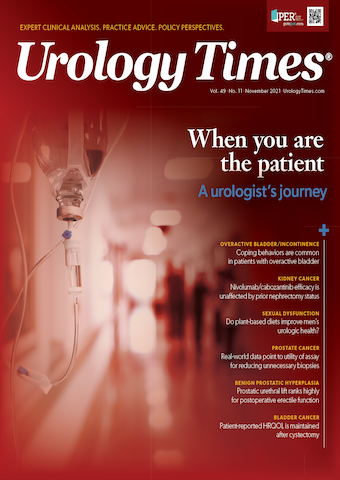Real-world data point to utility of assay for reducing unnecessary prostate biopsies
Real-world data attest to the efficacy of the IsoPSA assay for reducing unnecessary prostate biopsies.1
IsoPSA is a structure-based assay that is agnostic to the protein changes in prostate-specific antigen (PSA) that are directly linked to cancer biology, explained study author Eric A. Klein, MD, chairman of the Glickman Urological & Kidney Institute at Cleveland Clinic. Klein presented the findings during the 2021 American Urological Association Annual Meeting.
Eric A. Klein, MD

“We all know the limitations of PSA; it’s ‘prostate specific,’ not ‘prostate cancer-specific,’ and most men with ‘elevated’ PSA do not have prostate cancer,” Klein said. IsoPSA aims to address the limitations of PSA, Klein said.
An IsoPSA of 6.0 or lower has a 90% negative predictive value for the absence of high-grade cancer, whereas an IsoPSA higher than 6.0 has a 48% positive predictive value for the presence of high-grade cancer.
For the study, 38 providers in the Cleveland Clinic health system, which included urologic oncologists, general urologists, and advanced practice professionals, enrolled 900 patients who were being evaluated for prostate cancer. Of these patients, 734 met the study’s inclusion criteria, which included age 50 years or older, total serum PSA of 4 ng/mL to 100 ng/mL, and no history of prostate cancer. Median patient age was 67 years, 464 patients (63.2%) were 65 or older. Of the cohort, 324 (44.1%) patients had a prior negative biopsy. Providers were educated on IsoPSA performance.
“After reviewing the medical records for patients who ultimately received IsoPSA, the updated numbers of biopsy and/or MRI recommendations in this cohort were compared to their pre-IsoPSA recommendations,” the authors wrote.
Prior to IsoPSA being given, biopsies were recommended in 638 patients (86.9%); following IsoPSA, this number dropped to 284 (38.6%). In this group of 284 patients, IsoPSA was greater than 6.0 in 246 patients (86.6%) and 6.0 or lower in 38 patients (13.4%). Biopsy was not recommended in 41 patients (5.5%) prior to IsoPSA; this increased to 437 patients (59.5%) following IsoPSA. In this group of 437 patients, IsoPSA was greater than 6.0 in 25 (8.0%) of patients and 6.0 or lower in 402 patients (92.0%).
“In a real-world clinical setting, providers representing a broad range of practice styles, settings, education, and experience readily adopted IsoPSA to help risk stratify and generated about a 50% reduction in the number of prostate biopsies recommended,” Klein said.
Klein added that the findings suggest that IsoPSA could help reduce costs by reducing the number of unnecessary biopsies, increasing the cancer “yield” of biopsies that are preformed, and, in some cases, improving the detection of high-grade malignancy before disease progression.
Reference
1. Hettel D, Kestranek A, Rochelle R, Stovksy M, Klein E. IsoPSA substantially reduces unneeded biopsies in a real-world office setting. Paper presented at the 2021 American Urological Association annual meeting; September 10-13, 2021; virtual. Abstract MP05-20.

